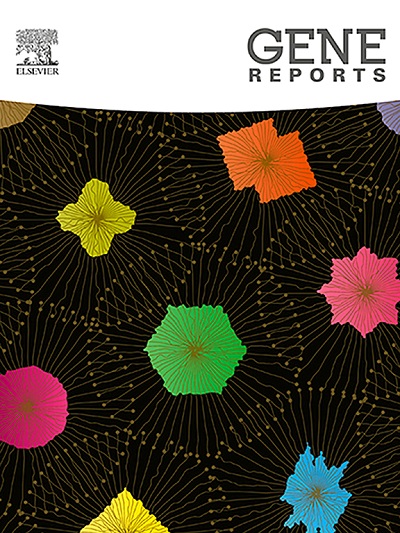Detection of a caf1 gene homolog associated with Yersinia pestis in rodent spleen samples in Lorestan Province, Iran
IF 1
Q4 GENETICS & HEREDITY
引用次数: 0
Abstract
This study aimed to investigate the presence of genes associated with Yersinia pestis, in rodents from plague reservoir environment in Lorestan Province, Iran.
In 2016 and 2017, rodents were trapped, and ectoparasites from their body surfaces were collected. DNA was extracted from the spleens of the rodents, and quantitative real-time polymerase chain reaction (qPCR) targeted the pla (pPCP1), caf1 (pMT1), and yihN genes, while conventional PCR was amplified the yihN, ymt, inv, and fur genes. IgG antibodies against the F1 capsular antigen of Y. pestis were assessed using enzyme-linked immunosorbent assay (ELISA), and specimens from the second year were cultured to isolate Y. pestis.
The most frequently captured rodent was Meriones persicus (49.59 %), followed by Mus. macedonicus (17.88 %). Of the 234 ectoparasites found, 174 were fleas (170 from Xenopsylla and 4 from Paradoxopsyllus and 60 were ticks from the Hyalomma genus. Four rodent spleen samples (one M. persicus, one Mus. macedonicus, and two Microtus spp.) tested positive for the caf1 gene homolog, but other genes associated with Y. pestis (pla, yihN, ymt, inv, and fur), IgG antibodies against the F1 antigen of Y. pestis, and culture tests were negative.
The presence of the caf1 gene, along with the absence of other Y. pestis genes and negative serology results, suggests identification of caf1 gene homolog, associated with Y. pestis in an unknown organism. Resource constraints limit our ability to conduct further tests for precise identification. Further studies should focus on additional tests to comprehensively identify the organism linked to the positive caf1 result.
伊朗Lorestan省啮齿动物脾脏标本中鼠疫耶尔森氏菌相关caf1基因同源物的检测
本研究旨在调查来自伊朗Lorestan省鼠疫水库环境的啮齿动物中鼠疫耶尔森菌相关基因的存在。2016年和2017年,对啮齿动物进行了诱捕,并从其体表收集了外寄生虫。提取小鼠脾脏DNA,采用实时荧光定量聚合酶链反应(quantitative real-time polymerase chain reaction, qPCR)对pla (pPCP1)、caf1 (pMT1)和yihN基因进行扩增,传统PCR对yihN、ymt、inv和fur基因进行扩增。采用酶联免疫吸附试验(ELISA)检测鼠疫菌F1荚膜抗原IgG抗体,培养第二年标本分离鼠疫菌。捕获频率最高的鼠类为灰鼠(49.59%),其次为小家鼠;马其顿(17.88%)。234只体表寄生虫中,蚤174只(客蚤170只、异蚤4只),透明蝇属蜱60只。鼠脾标本4份(鼠脾标本1份,鼠脾标本1份)。但与鼠疫菌相关的其他基因(pla、yihN、ymt、inv和fur)、针对鼠疫菌F1抗原的IgG抗体和培养试验均为阴性。caf1基因的存在,以及其他鼠疫菌基因的缺失和阴性血清学结果表明,在一种未知生物中发现了与鼠疫菌相关的caf1基因同源物。资源限制限制了我们进行进一步精确鉴定测试的能力。进一步的研究应侧重于其他测试,以全面确定与caf1阳性结果相关的生物体。
本文章由计算机程序翻译,如有差异,请以英文原文为准。
求助全文
约1分钟内获得全文
求助全文
来源期刊

Gene Reports
Biochemistry, Genetics and Molecular Biology-Genetics
CiteScore
3.30
自引率
7.70%
发文量
246
审稿时长
49 days
期刊介绍:
Gene Reports publishes papers that focus on the regulation, expression, function and evolution of genes in all biological contexts, including all prokaryotic and eukaryotic organisms, as well as viruses. Gene Reports strives to be a very diverse journal and topics in all fields will be considered for publication. Although not limited to the following, some general topics include: DNA Organization, Replication & Evolution -Focus on genomic DNA (chromosomal organization, comparative genomics, DNA replication, DNA repair, mobile DNA, mitochondrial DNA, chloroplast DNA). Expression & Function - Focus on functional RNAs (microRNAs, tRNAs, rRNAs, mRNA splicing, alternative polyadenylation) Regulation - Focus on processes that mediate gene-read out (epigenetics, chromatin, histone code, transcription, translation, protein degradation). Cell Signaling - Focus on mechanisms that control information flow into the nucleus to control gene expression (kinase and phosphatase pathways controlled by extra-cellular ligands, Wnt, Notch, TGFbeta/BMPs, FGFs, IGFs etc.) Profiling of gene expression and genetic variation - Focus on high throughput approaches (e.g., DeepSeq, ChIP-Seq, Affymetrix microarrays, proteomics) that define gene regulatory circuitry, molecular pathways and protein/protein networks. Genetics - Focus on development in model organisms (e.g., mouse, frog, fruit fly, worm), human genetic variation, population genetics, as well as agricultural and veterinary genetics. Molecular Pathology & Regenerative Medicine - Focus on the deregulation of molecular processes in human diseases and mechanisms supporting regeneration of tissues through pluripotent or multipotent stem cells.
 求助内容:
求助内容: 应助结果提醒方式:
应助结果提醒方式:


